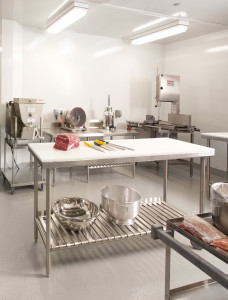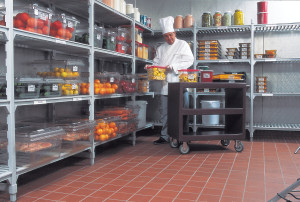Best Practices
The 3 C’s of Food Safety
Receiving Procedures
Product Rotation
The 3 C’s of Food Safety
Photo of commercial facilitiesThe 3 C’s of food safety are simple guidelines that all foodservice operators should practice. Safe handling procedures will help minimize potential risk and ensure that safe food leaves your kitchen at all times.
Keep it Cold
Cold Chain Management is the process of maintaining critical food temperatures along the supply chain, from manufacturing to serving. Maintaining the cold chain temperature limits the growth of harmful pathogens that could lead to a food-borne illness and also prevents excessive purge from the beef that reduces yield and product quality. Therefore, when preparing beef, it is important not to leave multiple cases of beef out at room temperature awaiting cutting. Similarly, never leave cases of product at the back door after delivery, waiting for a staff member to put them away.
Keep it Clean
Tips on CleanlinessBeef, like other proteins, fruits and vegetables, can harbour harmful bacteria. Providing a sanitized environment for storage, handling and preparation helps keep beef and other products safe. Preventing cross-contamination when handling and storing beef must be a priority for all food handlers. When beef is stored, ensure raw meat is covered and placed on lower shelves — this will prevent juices from coming in contact with cooked items on upper shelves. When cutting and preparing beef, use a clean workstation with cutting boards assigned for different classes of food (chicken, beef, fish, produce, etc.) and sanitize them between uses.
Keep it Covered
Similar to other meat products, beef will dry out if not covered during storage and handling, reducing the quality. Keeping beef covered also prevents cross-contamination to or from other products. Cooked beef should also be covered to keep it safe.
Download «A Design for Safety» for more information about safety (PDF)
Did you know
On initially opening a vacuum bag, an off door may be detected. This is not a sign the meat is bad, rather it is the lactic acid which develops in the bag where there is no oxygen. The door should dissipate within 10-15 minutes after being exposed to oxygen.
Be Preapred
Receiving scales are good to have near the back door for spot checking deliveries.
Receiving Procedures
Foodservice operators’ contribution to a safe food supply begins at the receiving door. Procedures should be in place to:
- Identify the quality, integrity and specifications of the products arriving at the restaurant
- Place the product in the right storage location to maximize shelf life
- Rotate inventory so the practice of first-in first-out (FIFO) is met.
Inspecting Beef on Arrival
The boxes of beef should be intact and clean and the temperature should be probed. If frozen, make sure the beef is completely frozen. With fresh product, look for «leakers» which are when the vacuum bags did not seal properly or the seal was broken at some point. Leakers will often contain sour product which is noticeable upon opening. It is best to make sure leakers are not used and are returned immediately so the cause of the leak can be determined. Customers should refuse any product that is too warm or not completely frozen, and a notation of the problem should be made for follow-up with the distributor and manufacturer. Leakers are easily identified as the bag is loose around the beef and the cuts move freely in the bag. A good vacuum will be very tight around the beef cut.
 The receiver should compare the box labels against the invoice to verify that the grade matches (A, AA, AAA, Prime), and the weights coincide. Any discrepancies should be noted and signed by the driver. The product specifications should be clearly identified, «0X1 STRIPLOINS», for example. Receivers and other staff should know how to identify beef specifications in order to determine accuracy as not all labels will be as clear as the one below. This typical packer label would appear on original packer boxes but if the product has been further processed (steaked, cooked, marinated, etc.), a different label may appear.
The receiver should compare the box labels against the invoice to verify that the grade matches (A, AA, AAA, Prime), and the weights coincide. Any discrepancies should be noted and signed by the driver. The product specifications should be clearly identified, «0X1 STRIPLOINS», for example. Receivers and other staff should know how to identify beef specifications in order to determine accuracy as not all labels will be as clear as the one below. This typical packer label would appear on original packer boxes but if the product has been further processed (steaked, cooked, marinated, etc.), a different label may appear.
The packing date, or the date the product was processed, should also be marked on the label. Counting back from this date will provide you the number of aging days. This number should be consistent with your beef specifications or your contracted aging requirement, if applicable.
Download the «Labelling Fact Sheet» for more information about labelling (PDF)
There are a number of labeling guidelines you should be familiar with. Monitoring label compliance is a function of the Canada Food Inspection Agency (CFIA).
- Only beef processed in a provincially or federally-inspected facility can be assigned a Canadian Grade Name by the Canadian Beef Grading Agency. Only beef from a federal facility can be traded inter-provincially and internationally.
- The word «Canada» and the appropriate grade must appear side by side in a grade designation, eg, Canada AAA.
- Imported beef may enter the country and be further manufactured (cut, cooked, etc.) and legally labelled «Product of Canada». The only assurance one has that the beef is Canadian is if it displays the grade name. Beef not marked with a Canada grade must be labelled «Ungraded» or the grade from its country of origin must be stated. These rules apply to all whole-muscle and portion-cut products, with the exception of stewing beef and ground beef.
It is necessary in a supply-demand market that products be traded fairly. Customers must get what they pay for and their guests must be served the entrées as advertised on the menu. If you suspect fraudulent practices as it relates to the representation of beef items, you are encouraged to contact your local branch of the Canadian Food Inspection Agency. You can also view the meat regulations at laws.justice.gc.ca.
Product Rotation
It is essential that proper storage and rotation is practised within your operation. Managing the product in the kitchen will ensure fewer losses on spoiled products and higher yields. Review FIFO (First In – First Out) procedures and consider implementing a «day dot program» to manage fresh inventories effectively. Assigning different coloured dot stickers for each day of the week will help ensure you are using the oldest product first.
Storage and Shelf Life
If storing beef under refrigeration, remember that temperatures in walk-in coolers can vary a great deal due to the opening and closing of the doors. Beef is best stored in the coldest spot – the bottom shelf of the back corner – furthest from the door. If storing frozen beef, ensure temperatures of -10°C to -18°C, or less, and keep the product in its original packaging to help minimize freezer burn. The following factors affect the storage life of beef:
- Initial low microbial count, influenced by the cleanliness of the beef at the packer and distributor level.
- Lack of cold chain management.
- Improper rotation of product at the distributor.
- Bone-in beef, versus boneless beef, has a higher bacterial count; thus, a shorter shelf life. (Boneless product has approximately 7-14 days additional shelf life than bone-in product.).
Storage Chart
Packaging |
Refrigerator(-2°C to 2°C) |
Freezer(-10°C to -18°C or less) |
|---|---|---|
|
|
||
| Vacuum Packed Cuts | 16+ days* | 6-12 months |
| Opened Vacuum Package | 2 days | After rewrapping: 3-6 months |
|
|
||
* Storage time under refrigeration depends on the age of the product when received and whether it is bone-in or boneless |
||
Frozen Beef
Many operators will purchase fresh beef and then freeze it themselves. Although this is a safe practice, it defeats the purpose of buying fresh beef. The operator will experience a higher degree of shrinkage from purge as the freezing facilities in most operations cannot duplicate the results of those at manufacturers’ facilities. Beef manufacturers use cryogenic freezer tunnels, which use liquid nitrogen at very cold temperatures resulting in a very quick-freeze. If the operator buys fresh beef and then freezes it, it may be more cost effective to buy frozen beef and to place emphasis on a well-planned tempering program.
There are a number of myths about frozen beef that require clarification. When handled correctly, frozen beef will usually produce the same eating quality of fresh beef.
Thawing Frozen Beef
If purchasing frozen beef, whole-muscle or portioned product, proper thawing is key to maintaining the beef quality.
Always
Thaw beef under refrigerated conditions whenever possible. For steaks, place packages on a baker’s sheet to allow quicker thaw and with larger whole-muscle cuts, allow sufficient time to completely thaw. A roast with a frozen center will take longer to cook and result in inconsistent doneness levels. If pressed for time, place steaks in a bus bin in the sink under cold running water.
Never
Use a microwave to thaw steaks as the meat will toughen and partially cook. Use hot water baths as steaks will cook and juices will leach from meat tissue. Thaw cuts at room temperature. In addition to being a food safety hazard, thawing at room temperature draws moisture out of beef creating a dryer finished product.
Red Colouring
As beef is packaged in the oxygen-free environment of the cryovac package, it will tend to be a deep red, purplish colour. Once the package is opened, the familiar red colour will bloom after 15-30 minutes of exposure to oxygen.
MYTH #1
Frozen beef does not retain the same quality as fresh beef.
If beef is properly aged, frozen quickly (i.e. cryogenically), and thawed slowly under refrigeration, the taste, juiciness and tenderness will rarely be affected. The only measurable difference is that there may be some additional purge with frozen beef.
MYTH #2
Frozen beef is old.
There are some who believe that frozen beef is a product that is old and has been frozen for excessive periods of time. Distributors make decisions to freeze beef based not only on the age of the product, but also on market conditions and purchasing opportunities. If packers need to quickly sell particular cuts, they may offer a discount which the distributor takes advantage of. Once the designated age is reached, only then is the product frozen.
MYTH #3
Frozen beef has no age.
The majority of beef that is frozen is usually fully aged since the aging process stops once the beef is frozen. When the beef thaws, the aging process will not restart.






